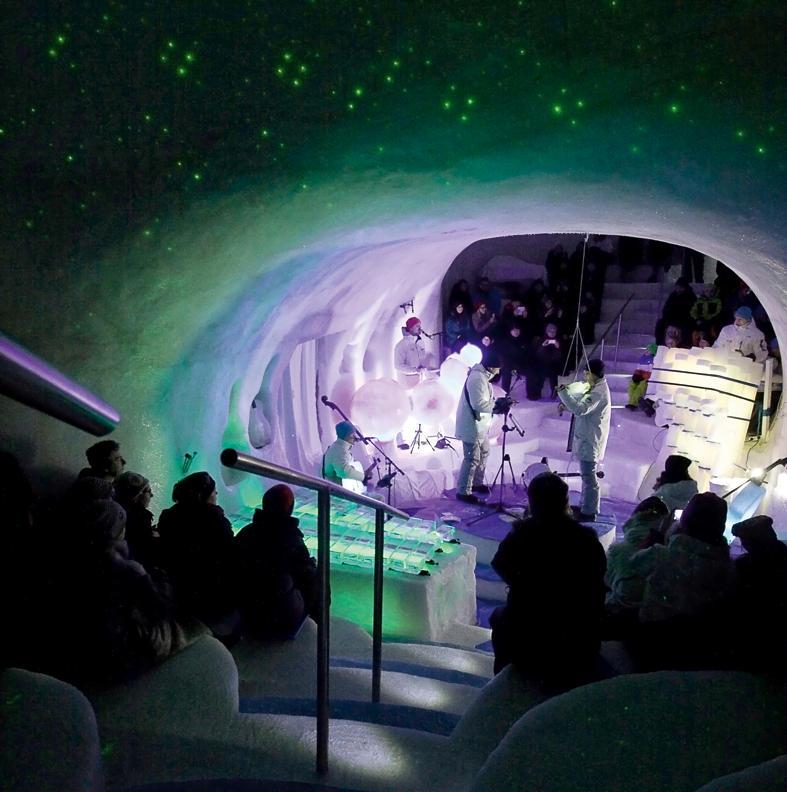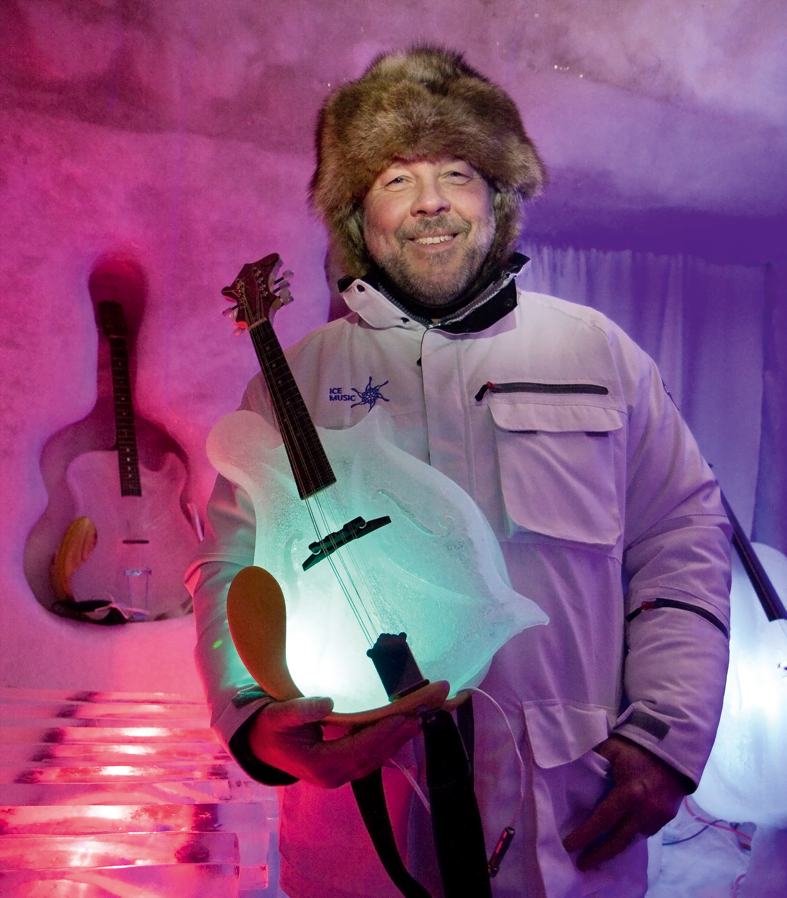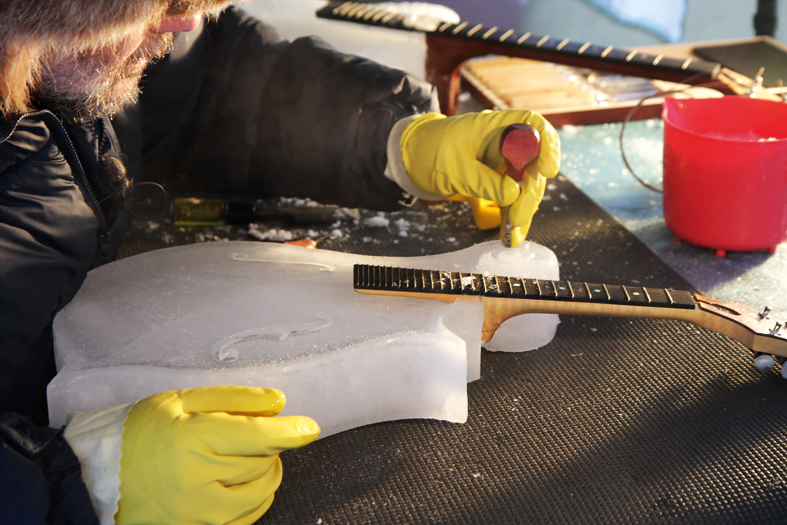To create a musical instrument from ice, it’s crucial to understand its strengths and weaknesses. For ice sculptor, Tim Linhart, it all began in Colorado, 20 years ago: “A friend who built guitars asked if it was possible to build an instrument out of ice. So I built a giant bass, put strings on it from a piano, tightened the strings, plucked them, and heard music. However, I thought if I just tightened the wires some more, it would be louder. Instead, the frozen bass exploded!” This was just the start of Tim Linhart’s long career creating many different ice instruments.

Coldplay
Ice absorbs vibrations, but not as much as wood, so the sound from an ice instrument is sharper and brighter than a traditional one. According to Tim, ice lets you hear more detail: “Because the ice is always changing, the crystals grow in different directions and there’s a lot of tension. When you send vibrations through the ice the molecules become more evenly spaced and flexible and good for creating music.”
And, just as a traditional wooden violin gets a richer sound with age, so does an ice instrument: “The more vibration, the mellower the sound,” says Tim. “The guitars in particular get a sweeter sound over time, as the ice gets thinner.”
To make an ice guitar, Tim builds the front and back plates out of ice and freezes them overnight. Then he carves the finer details and gradually builds up the space between the plates with ice. From there, a traditional neck, bridge and strings complete the instrument.
Sweden calling
Thirteen years ago, Tim was invited to Sweden to work with the Ice Hotel. Here, he built an ice pipe organ with 56 pipes, along with an ice orchestra. “I thought that this was going to be a great cold location for a concert,” says Tim.

“Of course, I’d not counted on 450 people showing up for the first concert! All the warm bodies meant the temperature went up from -4°C to about 12°C. The tuning of the instruments went nuts and it was a bit of a musical disaster! As the temperature rises, the stringed instruments go down in pitch and the pipe organ goes up.”
Ice auditorium
Following this, Tim began designing his own auditorium to provide good acoustics and keep temperature fluctuations to a minimum.
The result was the ice concert hall, constructed with two spherical igloos for the audience and a stage placed in the middle, slightly recessed to keep the temperature low. Tim created a vent at the top of each dome, allowing the warmth from people out and helping to maintain the optimal temperature of -5°C.
The walls of the concert hall are sprayed with water for a smooth ice finish, creating a reflective material that bounces the notes around and enabling the instruments to spread a powerful, crisp and rich sound throughout the room.
Challenging environment
“The acoustics are complex,” says Tim. “There’s an amazing sweet spot in the middle of the igloo, which is wonderful for all the sound. But there are also places where you can’t hear the bass drum, for example.”
Because ice is less resonant than wood or metal, amplification is required for the string instruments: “I make a small hole in the side of the guitars for a transducer. In violins, I use two transducers, so vibrations from both plates are picked up. I place the transducers as far away from the strings and the bridge as possible, because we want to hear the ice.”
Tim works closely with a sound engineer to manage the cold and moisture interfering with the different channels. “The whole environment is challenging because of the close proximity of electricity and water,” explains Tim. “Every now and then a buzz occurs and the sound engineer helps identify it. He goes round with a hairdryer – even sometimes fixing channels mid-concert!”

The LED lighting used inside the instruments – to brilliant atmospheric effect – can also result in interference in the sound system. “If a mic and LED light are too close within an instrument, it can cause a problem,” explains Tim. “We moved the LED lights out of the violins to avoid the issue.”
New designs
With the pitch problems in mind, Tim has invented new instruments, such as the ‘Graviton’ – a massive 37-string instrument with 2.2 tons of steel plates, some weighing up to 75 kg. The plates are hung on the end of the strings instead of tuning pegs. The weight creates tension in the ice and helps to hold consistent tuning. Another invention is the ‘Rolandophone’, which is a giant percussion instrument with 44 pipes that looks a bit like a pan flute.

To give everyone the best seat in the house, Tim is planning a new design for the next ice concert hall. He wants to add geometric billowed ribs on the roof of the new auditorium to enhance the acoustic experience. “If all goes to plan, the new concert hall will have a large dome in the centre for the orchestra, a dance floor, and three surrounding domes with space for 350 people,” concludes Tim.
“A friend who built guitars asked if it was possible to build an instrument out of ice. So I built a giant bass, put strings on it from a piano, tightened the strings, and heard music." Tim Linhart
See the glowing igloo concert hall and hear the ice instruments (4:11):
Related Products
Related WAVES Articles

